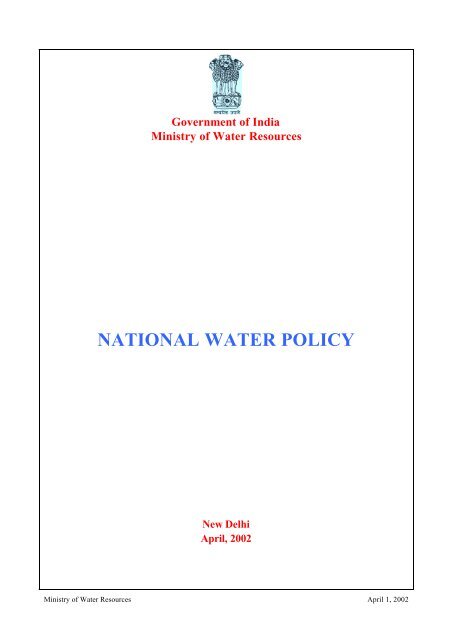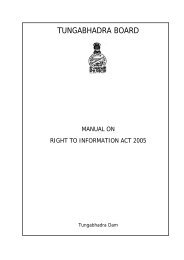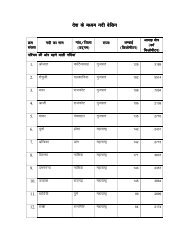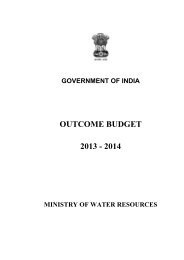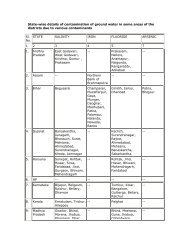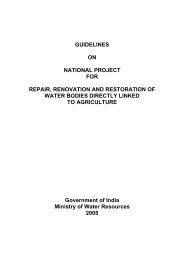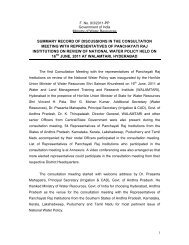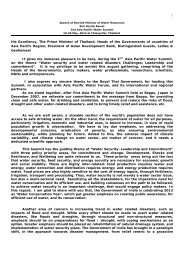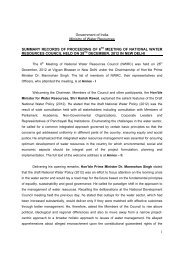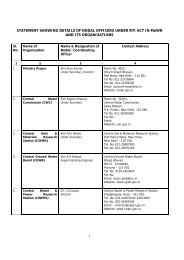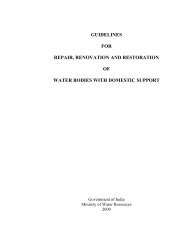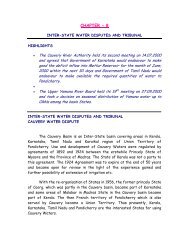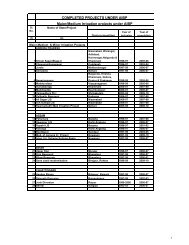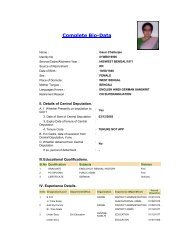National Water Policy 2002 - Ministry of Water Resources
National Water Policy 2002 - Ministry of Water Resources
National Water Policy 2002 - Ministry of Water Resources
You also want an ePaper? Increase the reach of your titles
YUMPU automatically turns print PDFs into web optimized ePapers that Google loves.
Government <strong>of</strong> India<br />
<strong>Ministry</strong> <strong>of</strong> <strong>Water</strong> <strong>Resources</strong><br />
NATIONAL WATER POLICY<br />
New Delhi<br />
April, <strong>2002</strong><br />
<strong>Ministry</strong> <strong>of</strong> <strong>Water</strong> <strong>Resources</strong> April 1, <strong>2002</strong>
Need for a <strong>National</strong> <strong>Water</strong> <strong>Policy</strong><br />
1.1 <strong>Water</strong> is a prime natural resource, a basic human need and a precious national asset. Planning,<br />
development and management <strong>of</strong> water resources need to be governed by national perspectives.<br />
1.2 As per the latest assessment (1993), out <strong>of</strong> the total precipitation, including snowfall, <strong>of</strong> around<br />
4000 billion cubic metre in the country, the availability from surface water and replenishable ground water<br />
is put at 1869 billion cubic metre. Because <strong>of</strong> topographical and other constraints, about 60% <strong>of</strong> this i.e. 690<br />
billion cubic metre from surface water and 432 billion cubic metre from ground water, can be put to<br />
beneficial use. Availability <strong>of</strong> water is highly uneven in both space and time. Precipitation is confined to<br />
only about three or four months in a year and varies from 100 mm in the western parts <strong>of</strong> Rajasthan to over<br />
10000 mm at Cherrapunji in Meghalaya. Rivers and under ground aquifers <strong>of</strong>ten cut across state boundaries.<br />
<strong>Water</strong>, as a resource is one and indivisible: rainfall, river waters, surface ponds and lakes and ground water<br />
are all part <strong>of</strong> one system.<br />
1.3 <strong>Water</strong> is part <strong>of</strong> a larger ecological system. Realising the importance and scarcity attached to the<br />
fresh water, it has to be treated as an essential environment for sustaining all life forms.<br />
1.4 <strong>Water</strong> is a scarce and precious national resource to be planned, developed, conserved and managed<br />
as such, and on an integrated and environmentally sound basis, keeping in view the socio-economic aspects<br />
and needs <strong>of</strong> the States. It is one <strong>of</strong> the most crucial elements in developmental planning. As the country has<br />
entered the 21 st century, efforts to develop, conserve, utilise and manage this important resource in a<br />
sustainable manner, have to be guided by the national perspective.<br />
1.5 Floods and droughts affect vast areas <strong>of</strong> the country, transcending state boundaries. One-sixth area<br />
<strong>of</strong> the country is drought-prone. Out <strong>of</strong> 40 million hectare <strong>of</strong> the flood prone area in the country, on an<br />
average, floods affect an area <strong>of</strong> around 7.5 million hectare per year. Approach to management <strong>of</strong> droughts<br />
and floods has to be co-ordinated and guided at the national level.<br />
1.6 Planning and implementation <strong>of</strong> water resources projects involve a number <strong>of</strong> socio-economic<br />
aspects and issues such as environmental sustainability, appropriate resettlement and rehabilitation <strong>of</strong><br />
project-affected people and livestock, public health concerns <strong>of</strong> water impoundment, dam safety etc.<br />
Common approaches and guidelines are necessary on these matters. Moreover, certain problems and<br />
weaknesses have affected a large number <strong>of</strong> water resources projects all over the country. There have been<br />
substantial time and cost overruns on projects. Problems <strong>of</strong> water logging and soil salinity have emerged in<br />
some irrigation commands, leading to the degradation <strong>of</strong> agricultural land. Complex issues <strong>of</strong> equity and<br />
social justice in regard to water distribution are required to be addressed. The development, and overexploitation<br />
<strong>of</strong> groundwater resources in certain parts <strong>of</strong> the country have raised the concern and need for<br />
judicious and scientific resource management and conservation. All these concerns need to be addressed on<br />
the basis <strong>of</strong> common policies and strategies.<br />
1.7 Growth process and the expansion <strong>of</strong> economic activities inevitably lead to increasing demands for<br />
water for diverse purposes: domestic, industrial, agricultural, hydro-power, thermal-power, navigation,<br />
recreation, etc. So far, the major consumptive use <strong>of</strong> water has been for irrigation. While the gross<br />
irrigation potential is estimated to have increased from 19.5 million hectare at the time <strong>of</strong> independence to<br />
about 95 million hectare by the end <strong>of</strong> the Year 1999-2000, further development <strong>of</strong> a substantial order is<br />
necessary if the food and fiber needs <strong>of</strong> our growing population are to be met with. The country’s<br />
population which is over 1027 million (2001 AD) at present is expected to reach a level <strong>of</strong> around 1390<br />
million by 2025 AD.<br />
<strong>Ministry</strong> <strong>of</strong> <strong>Water</strong> <strong>Resources</strong> 1 April 1, <strong>2002</strong>
1.8 Production <strong>of</strong> food grains has increased from around 50 million tonnes in the fifties to about 208<br />
million tonnes in the Year 1999-2000. This will have to be raised to around 350 million tonnes by the year<br />
2025 AD. The drinking water needs <strong>of</strong> people and livestock have also to be met. Domestic and industrial<br />
water needs have largely been concentrated in or near major cities. However, the demand in rural areas is<br />
expected to increase sharply as the development programmes improve economic conditions <strong>of</strong> the rural<br />
masses. Demand for water for hydro and thermal power generation and for other industrial uses is also<br />
increasing substantially. As a result, water, which is already a scarce resource, will become even scarcer in<br />
future. This underscores the need for the utmost efficiency in water utilisation and a public awareness <strong>of</strong> the<br />
importance <strong>of</strong> its conservation.<br />
1.9 Another important aspect is water quality. Improvements in existing strategies, innovation <strong>of</strong> new<br />
techniques resting on a strong science and technology base are needed to eliminate the pollution <strong>of</strong> surface<br />
and ground water resources, to improve water quality. Science and technology and training have to play<br />
important roles in water resources development and management in general.<br />
1.10 <strong>National</strong> <strong>Water</strong> <strong>Policy</strong> was adopted in September, 1987. Since then, a number <strong>of</strong> issues and<br />
challenges have emerged in the development and management <strong>of</strong> the water resources. Therefore, the<br />
<strong>National</strong> <strong>Water</strong> <strong>Policy</strong> (1987) has been reviewed and updated.<br />
Information System<br />
2.1 A well developed information system, for water related data in its entirety, at the national / state<br />
level, is a prime requisite for resource planning. A standardised national information system should be<br />
established with a network <strong>of</strong> data banks and data bases, integrating and strengthening the existing Central<br />
and State level agencies and improving the quality <strong>of</strong> data and the processing capabilities.<br />
2.2 Standards for coding, classification, processing <strong>of</strong> data and methods / procedures for its collection<br />
should be adopted. Advances in information technology must be introduced to create a modern information<br />
system promoting free exchange <strong>of</strong> data among various agencies. Special efforts should be made to develop<br />
and continuously upgrade technological capability to collect, process and disseminate reliable data in the<br />
desired time frame.<br />
2.3 Apart from the data regarding water availability and actual water use, the system should also include<br />
comprehensive and reliable projections <strong>of</strong> future demands <strong>of</strong> water for diverse purposes.<br />
<strong>Water</strong> <strong>Resources</strong> Planning<br />
3.1 <strong>Water</strong> resources available to the country should be brought within the category <strong>of</strong> utilisable<br />
resources to the maximum possible extent.<br />
3.2 Non-conventional methods for utilisation <strong>of</strong> water such as through inter-basin transfers, artificial<br />
recharge <strong>of</strong> ground water and desalination <strong>of</strong> brackish or sea water as well as traditional water conservation<br />
practices like rainwater harvesting, including ro<strong>of</strong>-top rainwater harvesting, need to be practiced to further<br />
increase the utilisable water resources. Promotion <strong>of</strong> frontier research and development, in a focused<br />
manner, for these techniques is necessary.<br />
3.3 <strong>Water</strong> resources development and management will have to be planned for a hydrological unit such<br />
as drainage basin as a whole or for a sub-basin, multi-sectorally, taking into account surface and ground<br />
water for sustainable use incorporating quantity and quality aspects as well as environmental considerations.<br />
All individual developmental projects and proposals should be formulated and considered within the<br />
framework <strong>of</strong> such an overall plan keeping in view the existing agreements / awards for a basin or a subbasin<br />
so that the best possible combination <strong>of</strong> options can be selected and sustained.<br />
<strong>Ministry</strong> <strong>of</strong> <strong>Water</strong> <strong>Resources</strong> 2 April 1, <strong>2002</strong>
3.4 <strong>Water</strong>shed management through extensive soil conservation, catchment-area treatment, preservation<br />
<strong>of</strong> forests and increasing the forest cover and the construction <strong>of</strong> check-dams should be promoted. Efforts<br />
shall be to conserve the water in the catchment.<br />
3.5 <strong>Water</strong> should be made available to water short areas by transfer from other areas including transfers<br />
from one river basin to another, based on a national perspective, after taking into account the requirements<br />
<strong>of</strong> the areas / basins.<br />
Institutional Mechanism<br />
4.1 With a view to give effect to the planning, development and management <strong>of</strong> the water resources on a<br />
hydrological unit basis, along with a multi-sectoral, multi-disciplinary and participatory approach as well as<br />
integrating quality, quantity and the environmental aspects, the existing institutions at various levels under<br />
the water resources sector will have to be appropriately reoriented / reorganised and even created, wherever<br />
necessary. As maintenance <strong>of</strong> water resource schemes is under non-plan budget, it is generally being<br />
neglected. The institutional arrangements should be such that this vital aspect is given importance equal or<br />
even more than that <strong>of</strong> new constructions.<br />
4.2 Appropriate river basin organisations should be established for the planned development and<br />
management <strong>of</strong> a river basin as a whole or sub-basins, wherever necessary. Special multi-disciplinary units<br />
should be set up to prepare comprehensive plans taking into account not only the needs <strong>of</strong> irrigation but also<br />
harmonising various other water uses, so that the available water resources are determined and put to<br />
optimum use having regard to existing agreements or awards <strong>of</strong> Tribunals under the relevant laws. The<br />
scope and powers <strong>of</strong> the river basin organisations shall be decided by the basin states themselves.<br />
<strong>Water</strong> Allocation Priorities<br />
5. In the planning and operation <strong>of</strong> systems, water allocation priorities should be broadly as follows:<br />
• Drinking water<br />
• Irrigation<br />
• Hydro-power<br />
• Ecology<br />
• Agro-industries and non-agricultural industries<br />
• Navigation and other uses.<br />
However, the priorities could be modified or added if warranted by the area / region specific<br />
considerations.<br />
Project Planning<br />
6.1 <strong>Water</strong> resource development projects should as far as possible be planned and developed as<br />
multipurpose projects. Provision for drinking water should be a primary consideration.<br />
6.2 The study <strong>of</strong> the likely impact <strong>of</strong> a project during construction and later on human lives, settlements,<br />
occupations, socio-economic, environment and other aspects shall form an essential component <strong>of</strong> project<br />
planning.<br />
6.3 In the planning, implementation and operation <strong>of</strong> a project, the preservation <strong>of</strong> the quality <strong>of</strong><br />
environment and the ecological balance should be a primary consideration. The adverse impact on the<br />
environment, if any, should be minimised and should be <strong>of</strong>fset by adequate compensatory measures. The<br />
project should, nevertheless, be sustainable.<br />
<strong>Ministry</strong> <strong>of</strong> <strong>Water</strong> <strong>Resources</strong> 3 April 1, <strong>2002</strong>
6.4 There should be an integrated and multi-disciplinary approach to the planning, formulation,<br />
clearance and implementation <strong>of</strong> projects, including catchment area treatment and management,<br />
environmental and ecological aspects, the rehabilitation <strong>of</strong> affected people and command area development.<br />
The planning <strong>of</strong> projects in hilly areas should take into account the need to provide assured drinking water,<br />
possibilities <strong>of</strong> hydro-power development and the proper approach to irrigation in such areas, in the context<br />
<strong>of</strong> physical features and constraints <strong>of</strong> the basin such as steep slopes, rapid run-<strong>of</strong>f and the incidence <strong>of</strong> soil<br />
erosion. The economic evaluation <strong>of</strong> projects in such areas should also take these factors into account.<br />
6.5 Special efforts should be made to investigate and formulate projects either in, or for the benefit <strong>of</strong>,<br />
areas inhabited by tribal or other specially disadvantaged groups such as socially weak, scheduled castes and<br />
scheduled tribes. In other areas also, project planning should pay special attention to the needs <strong>of</strong> scheduled<br />
castes and scheduled tribes and other weaker sections <strong>of</strong> the society. The economic evaluation <strong>of</strong> projects<br />
benefiting such disadvantaged sections should also take these factors into account.<br />
6.6 The drainage system should form an integral part <strong>of</strong> any irrigation project right from the planning<br />
stage.<br />
6.7 Time and cost overruns and deficient realisation <strong>of</strong> benefits characterising most water related<br />
projects should be overcome by upgrading the quality <strong>of</strong> project preparation and management. The<br />
inadequate funding <strong>of</strong> projects should be obviated by an optimal allocation <strong>of</strong> resources on the basis <strong>of</strong><br />
prioritisation, having regard to the early completion <strong>of</strong> on-going projects as well as the need to reduce<br />
regional imbalances.<br />
6.8 The involvement and participation <strong>of</strong> beneficiaries and other stakeholders should be encouraged<br />
right from the project planning stage itself.<br />
Ground <strong>Water</strong> Development<br />
7.1 There should be a periodical reassessment <strong>of</strong> the ground water potential on a scientific basis, taking<br />
into consideration the quality <strong>of</strong> the water available and economic viability <strong>of</strong> its extraction.<br />
7.2 Exploitation <strong>of</strong> ground water resources should be so regulated as not to exceed the recharging<br />
possibilities, as also to ensure social equity. The detrimental environmental consequences <strong>of</strong> overexploitation<br />
<strong>of</strong> ground water need to be effectively prevented by the Central and State Governments. Ground<br />
water recharge projects should be developed and implemented for improving both the quality and<br />
availability <strong>of</strong> ground water resource.<br />
7.3 Integrated and coordinated development <strong>of</strong> surface water and ground water resources and their<br />
conjunctive use, should be envisaged right from the project planning stage and should form an integral part<br />
<strong>of</strong> the project implementation.<br />
7.4 Over exploitation <strong>of</strong> ground water should be avoided especially near the coast to prevent ingress <strong>of</strong><br />
seawater into sweet water aquifers.<br />
Drinking <strong>Water</strong><br />
8. Adequate safe drinking water facilities should be provided to the entire population both in urban and<br />
in rural areas. Irrigation and multipurpose projects should invariably include a drinking water component,<br />
wherever there is no alternative source <strong>of</strong> drinking water. Drinking water needs <strong>of</strong> human beings and<br />
animals should be the first charge on any available water.<br />
<strong>Ministry</strong> <strong>of</strong> <strong>Water</strong> <strong>Resources</strong> 4 April 1, <strong>2002</strong>
Irrigation<br />
9.1 Irrigation planning either in an individual project or in a basin as a whole should take into account<br />
the irrigability <strong>of</strong> land, cost-effective irrigation options possible from all available sources <strong>of</strong> water and<br />
appropriate irrigation techniques for optimising water use efficiency. Irrigation intensity should be such as to<br />
extend the benefits <strong>of</strong> irrigation to as large a number <strong>of</strong> farm families as possible, keeping in view the need<br />
to maximise production.<br />
9.2 There should be a close integration <strong>of</strong> water-use and land-use policies.<br />
9.3 <strong>Water</strong> allocation in an irrigation system should be done with due regard to equity and social justice.<br />
Disparities in the availability <strong>of</strong> water between head-reach and tail-end farms and between large and small<br />
farms should be obviated by adoption <strong>of</strong> a rotational water distribution system and supply <strong>of</strong> water on a<br />
volumetric basis subject to certain ceilings and rational pricing.<br />
9.4 Concerted efforts should be made to ensure that the irrigation potential created is fully utilised. For<br />
this purpose, the command area development approach should be adopted in all irrigation projects.<br />
9.5 Irrigation being the largest consumer <strong>of</strong> fresh water, the aim should be to get optimal productivity<br />
per unit <strong>of</strong> water. Scientific water management, farm practices and sprinkler and drip system <strong>of</strong> irrigation<br />
should be adopted wherever feasible.<br />
9.6 Reclamation <strong>of</strong> water logged / saline affected land by scientific and cost-effective methods should<br />
form a part <strong>of</strong> command area development programme.<br />
Resettlement and Rehabilitation<br />
10. Optimal use <strong>of</strong> water resources necessitates construction <strong>of</strong> storages and the consequent resettlement<br />
and rehabilitation <strong>of</strong> population. A skeletal national policy in this regard needs to be formulated so that the<br />
project affected persons share the benefits through proper rehabilitation. States should accordingly evolve<br />
their own detailed resettlement and rehabilitation policies for the sector, taking into account the local<br />
conditions. Careful planning is necessary to ensure that the construction and rehabilitation activities proceed<br />
simultaneously and smoothly.<br />
Financial and Physical Sustainability<br />
11. Besides creating additional water resources facilities for various uses, adequate emphasis needs to be<br />
given to the physical and financial sustainability <strong>of</strong> existing facilities. There is, therefore, a need to ensure<br />
that the water charges for various uses should be fixed in such a way that they cover at least the operation<br />
and maintenance charges <strong>of</strong> providing the service initially and a part <strong>of</strong> the capital costs subsequently. These<br />
rates should be linked directly to the quality <strong>of</strong> service provided. The subsidy on water rates to the<br />
disadvantaged and poorer sections <strong>of</strong> the society should be well targeted and transparent.<br />
Participatory Approach to <strong>Water</strong> <strong>Resources</strong> Management<br />
12. Management <strong>of</strong> the water resources for diverse uses should incorporate a participatory approach; by<br />
involving not only the various governmental agencies but also the users and other stakeholders, in an<br />
effective and decisive manner, in various aspects <strong>of</strong> planning, design, development and management <strong>of</strong> the<br />
water resources schemes. Necessary legal and institutional changes should be made at various levels for the<br />
purpose, duly ensuring appropr iate role for women. <strong>Water</strong> Users’ Associations and the local bodies such as<br />
municipalities and gram panchayats should particularly be involved in the operation, maintenance and<br />
management <strong>of</strong> water infrastructures / facilities at appropriate levels progressively, with a view to eventually<br />
transfer the management <strong>of</strong> such facilities to the user groups / local bodies.<br />
<strong>Ministry</strong> <strong>of</strong> <strong>Water</strong> <strong>Resources</strong> 5 April 1, <strong>2002</strong>
Private Sector Participation<br />
13. Private sector participation should be encouraged in planning, development and management <strong>of</strong><br />
water resources projects for diverse uses, wherever feasible. Private sector participation may help in<br />
introducing innovative ideas, generating financial resources and introducing corporate management and<br />
improving service efficiency and accountability to users. Depending upon the specific situations, various<br />
combinations <strong>of</strong> private sector participation, in building, owning, operating, leasing and transferring <strong>of</strong> water<br />
resources facilities, may be considered.<br />
<strong>Water</strong> Quality<br />
14.1 Both surface water and ground water should be regularly monitored for quality. A phased<br />
programme should be undertaken for improvements in water quality.<br />
14.2 Effluents should be treated to acceptable levels and standards before discharging them into natural<br />
streams.<br />
14.3 Minimum flow should be ensured in the perennial streams for maintaining ecology and social<br />
considerations.<br />
14.4 Principle <strong>of</strong> ‘polluter pays’ should be followed in management <strong>of</strong> polluted water.<br />
14.5 Necessary legislation is to be made for preservation <strong>of</strong> existing water bodies by preventing<br />
encroachment and deterioration <strong>of</strong> water quality.<br />
<strong>Water</strong> Zoning<br />
15. Economic development and activities including agricultural, industrial and urban development,<br />
should be planned with due regard to the constraints imposed by the configuration <strong>of</strong> water availability.<br />
There should be a water zoning <strong>of</strong> the country and the economic activities should be guided and regulated in<br />
accordance with such zoning.<br />
Conservation <strong>of</strong> <strong>Water</strong><br />
16.1 Efficiency <strong>of</strong> utilisation in all the diverse uses <strong>of</strong> water should be optimised and an awareness <strong>of</strong><br />
water as a scarce resource should be fostered. Conservation consciousness should be promoted through<br />
education, regulation, incentives and disincentives.<br />
16.2 The resources should be conserved and the availability augmented by maximising retention,<br />
eliminating pollution and minimising losses. For this, measures like selective linings in the conveyance<br />
system, modernisation and rehabilitation <strong>of</strong> existing systems including tanks, recycling and re-use <strong>of</strong> treated<br />
effluents and adoption <strong>of</strong> traditional techniques like mulching or pitcher irrigation and new techniques like<br />
drip and sprinkler may be promoted, wherever feasible.<br />
Flood Control and Management<br />
17.1 There should be a master plan for flood control and management for each flood prone basin.<br />
17.2 Adequate flood-cushion should be provided in water storage projects, wherever feasible, to facilitate<br />
better flood management. In highly flood prone areas, flood control should be given overriding<br />
consideration in reservoir regulation policy even at the cost <strong>of</strong> sacrificing some irrigation or power benefits.<br />
<strong>Ministry</strong> <strong>of</strong> <strong>Water</strong> <strong>Resources</strong> 6 April 1, <strong>2002</strong>
17.3 While physical flood protection works like embankments and dykes will continue to be necessary,<br />
increased emphasis should be laid on non-structural measures such as flood forecasting and warning, flood<br />
plain zoning and flood pro<strong>of</strong>ing for the minimisation <strong>of</strong> losses and to reduce the recurring expenditure on<br />
flood relief.<br />
17.4 There should be strict regulation <strong>of</strong> settlements and economic activity in the flood plain zones along<br />
with flood pro<strong>of</strong>ing, to minimise the loss <strong>of</strong> life and property on account <strong>of</strong> floods.<br />
17.5 The flood forecasting activities should be modernised, value added and extended to other uncovered<br />
areas. Inflow forecasting to reservoirs should be instituted for their effective regulation.<br />
Land Erosion by Sea or River<br />
18.1 The erosion <strong>of</strong> land, whether by the sea in coastal areas or by river waters inland, should be<br />
minimised by suitable cost-effective measures. The States and Union Territories should also undertake all<br />
requisite steps to ensure that indiscriminate occupation and exploitation <strong>of</strong> coastal strips <strong>of</strong> land are<br />
discouraged and that the location <strong>of</strong> economic activities in areas adjacent to the sea is regulated.<br />
18.2 Each coastal State should prepare a comprehensive coastal land management plan, keeping in view<br />
the environmental and ecological impacts, and regulate the developmental activities accordingly.<br />
Drought-prone Area Development<br />
19.1 Drought-prone areas should be made less vulnerable to drought-associated problems through soilmoisture<br />
conservation measures, water harvesting practices, minimisation <strong>of</strong> evaporation losses,<br />
development <strong>of</strong> the ground water potential including recharging and the transfer <strong>of</strong> surface water from<br />
surplus areas where feasible and appropriate. Pastures, forestry or other modes <strong>of</strong> development which are<br />
relatively less water demanding should be encouraged. In planning water resource development projects, the<br />
needs <strong>of</strong> drought-prone areas should be given priority.<br />
19.2 Relief works undertaken for providing employment to drought-stricken population should preferably<br />
be for drought pro<strong>of</strong>ing.<br />
Monitoring <strong>of</strong> Projects<br />
20.1 A close monitoring <strong>of</strong> projects to identify bottlenecks and to adopt timely measures to obviate time<br />
and cost overrun should form part <strong>of</strong> project planning and execution.<br />
20.2 There should be a system to monitor and evaluate the performance and socio-economic impact <strong>of</strong><br />
the project.<br />
<strong>Water</strong> Sharing / Distribution amongst the States<br />
21.1 The water sharing / distribution amongst the states should be guided by a national perspective with<br />
due regard to water resources availability and needs within the river basin. Necessary guidelines, including<br />
for water short states even outside the basin, need to be evolved for facilitating future agreements amongst<br />
the basin states.<br />
21.2 The Inter-State <strong>Water</strong> Disputes Act <strong>of</strong> 1956 may be suitably reviewed and amended for timely<br />
adjudication <strong>of</strong> water disputes referred to the Tribunal.<br />
<strong>Ministry</strong> <strong>of</strong> <strong>Water</strong> <strong>Resources</strong> 7 April 1, <strong>2002</strong>
Performance Improvement<br />
22. There is an urgent need <strong>of</strong> paradigm shift in the emphasis in the management <strong>of</strong> water resources<br />
sector. From the present emphasis on the creation and expansion <strong>of</strong> water resources infrastructures for<br />
diverse uses, there is now a need to give greater emphasis on the improvement <strong>of</strong> the performance <strong>of</strong> the<br />
existing water resources facilities. Therefore, allocation <strong>of</strong> funds under the water resources sector should be<br />
re-prioritised to ensure that the needs for development as well as operation and maintenance <strong>of</strong> the facilities<br />
are met.<br />
Maintenance and Modernisation<br />
23.1 Structures and systems created through massive investments should be properly maintained in good<br />
health. Appropriate annual provisions should be made for this purpose in the budgets.<br />
23.2 There should be a regular monitoring <strong>of</strong> structures and systems and necessary rehabilitation and<br />
modernisation programmes should be undertaken.<br />
23.3 Formation <strong>of</strong> <strong>Water</strong> Users' Association with authority and responsibility should be encouraged to<br />
facilitate the management including maintenance <strong>of</strong> irrigation system in a time bound manner.<br />
Safety <strong>of</strong> Structures<br />
24. There should be proper organisational arrangements at the national and state levels for ensuring the<br />
safety <strong>of</strong> storage dams and other water-related structures consisting <strong>of</strong> specialists in investigation, design,<br />
construction, hydrology, geology, etc. A dam safety legislation may be enacted to ensure proper inspection,<br />
maintenance and surveillance <strong>of</strong> existing dams and also to ensure proper planning, investigation, design and<br />
construction for safety <strong>of</strong> new dams. The Guidelines on the subject should be periodically updated and<br />
reformulated. There should be a system <strong>of</strong> continuous surveillance and regular visits by experts.<br />
Science and Technology<br />
25. For effective and economical management <strong>of</strong> our water resources, the frontiers <strong>of</strong> knowledge need<br />
to be pushed forward in several directions by intensifying research efforts in various areas, including the<br />
following:<br />
• hydrometeorology;<br />
• snow and lake hydrology;<br />
• surface and ground water hydrology;<br />
• river morphology and hydraulics;<br />
• assessment <strong>of</strong> water resources;<br />
• water harvesting and ground water recharge;<br />
• water quality;<br />
• water conservation;<br />
• evaporation and seepage losses;<br />
• recycling and re-use;<br />
• better water management practices and improvements in operational technology;<br />
• crops and cropping systems;<br />
• soils and material research;<br />
<strong>Ministry</strong> <strong>of</strong> <strong>Water</strong> <strong>Resources</strong> 8 April 1, <strong>2002</strong>
Training<br />
• new construction materials and technology (with particular reference to roller compacted<br />
concrete, fiber reinforced concrete, new methodologies in tunneling technologies,<br />
instrumentation, advanced numerical analysis in structures and back analysis);<br />
• seismology and seismic design <strong>of</strong> structures;<br />
• the safety and longevity <strong>of</strong> water-related structures;<br />
• economical designs for water resource projects;<br />
• risk analysis and disaster management;<br />
• use <strong>of</strong> remote sensing techniques in development and management;<br />
• use <strong>of</strong> static ground water resource as a crisis management measure;<br />
• sedimentation <strong>of</strong> reservoirs;<br />
• use <strong>of</strong> sea water resources;<br />
• prevention <strong>of</strong> salinity ingress;<br />
• prevention <strong>of</strong> water logging and soil salinity;<br />
• reclamation <strong>of</strong> water logged and saline lands;<br />
• environmental impact;<br />
• regional equity.<br />
26. A perspective plan for standardised training should be an integral part <strong>of</strong> water resource<br />
development. It should cover training in information systems, sectoral planning, project planning and<br />
formulation, project management, operation <strong>of</strong> projects and their physical structures and systems and the<br />
management <strong>of</strong> the water distribution systems. The training should extend to all the categories <strong>of</strong> personnel<br />
involved in these activities as also the farmers.<br />
Conclusion<br />
27. In view <strong>of</strong> the vital importance <strong>of</strong> water for human and animal life, for maintaining ecological<br />
balance and for economic and developmental activities <strong>of</strong> all kinds, and considering its increasing scarcity,<br />
the planning and management <strong>of</strong> this resource and its optimal, economical and equitable use has become a<br />
matter <strong>of</strong> the utmost urgency. Concerns <strong>of</strong> the community needs to be taken into account for water resources<br />
development and management. The success <strong>of</strong> the <strong>National</strong> <strong>Water</strong> <strong>Policy</strong> will depend entirely on evolving<br />
and maintaining a national consensus and commitment to its underlying principles and objectives. To<br />
achieve the desired objectives, State <strong>Water</strong> <strong>Policy</strong> backed with an operational action plan shall be formulated<br />
in a time bound manner say in two years. <strong>National</strong> <strong>Water</strong> <strong>Policy</strong> may be revised periodically as and when<br />
need arises.<br />
____________<br />
<strong>Ministry</strong> <strong>of</strong> <strong>Water</strong> <strong>Resources</strong> 9 April 1, <strong>2002</strong>


